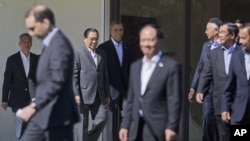The ten member states of the Association of Southeast Asian Nations failed to issue a joint statement about the South China Sea during a meeting of its foreign ministers in China, which analysts have said is evidence of deep divisions in the political bloc.
“It shows the cracks in Asean as well as the cracks between China and Asean, because this year is the 25th anniversary of Asean-China,” said Chheang Vannarith, co-founder and chairman of the Cambodian Institute for Strategic Studies.
“If Asean and China do not find a good way to solve and control the crisis, the dispute, and the regional tension, it may affect the good relationship between Asean and China.”
Cambodia, Laos, and Burma appear to favor China’s policy over the disputed waters of the South China Sea as there was a last-minute withdrawal of their support for issuing the joint statement after last week’s meeting of Asean foreign ministers and the Chinese foreign minister.
Vannarith questioned the role of Asean in dealing with the conflict.
“The Joint Statement reflects unity and the initiative to push for cooperation. If Asean cannot issue a joint statement, it means Asean does not have a consensus in making decisions as well as to set a plan to do so in the future, to push forward for bilateral cooperation. So it affects the unity [of Asean] and also regional stability.”
A verdict in a case filed in 2013 by the Philippines regarding the disputed waters is expected in the coming month, which may escalate tensions, Vannarith added.
Asean and China have strong economic ties, with China the largest economic partner of the region. Vannarith warned that the threat of armed conflict over the South China Sea could not only be bad for the economies of Southeast Asia, but for the wider Asia-Pacific region as well.
“So political instability and insecurity may heavily affect economic development in the region,” he said.
“Economic benefit is a core element to define a foreign policy between countries in the region, especially Cambodia, Laos and Myanmar.”
Vannarith said it surprised him that Myanmar did not turn its policy toward the West after the recent election.
He said Vietnam’s influence in Cambodia had changed as Cambodia had turned toward China for the economic benefit.
“The political trend in Cambodian foreign policy was a move toward China for economic interests, but the current government is trying to continue its good relationship with Vietnam, too. However, Vietnam’s influence in Cambodia has declined if compared to China’s influence in Cambodia. So, it reflects a change in relations from Cambodia and Vietnam to Cambodia and China.”
He added that it would be difficult to find a solution to restoring the Asean-China relationship, “but if Asean can continue its core role in the region, it can maintain stability and security to a certain level.”
“But if Asean splits and there is high competition between China and the United States, then our region will fall into instability and it will have a huge impact on economic development.”









